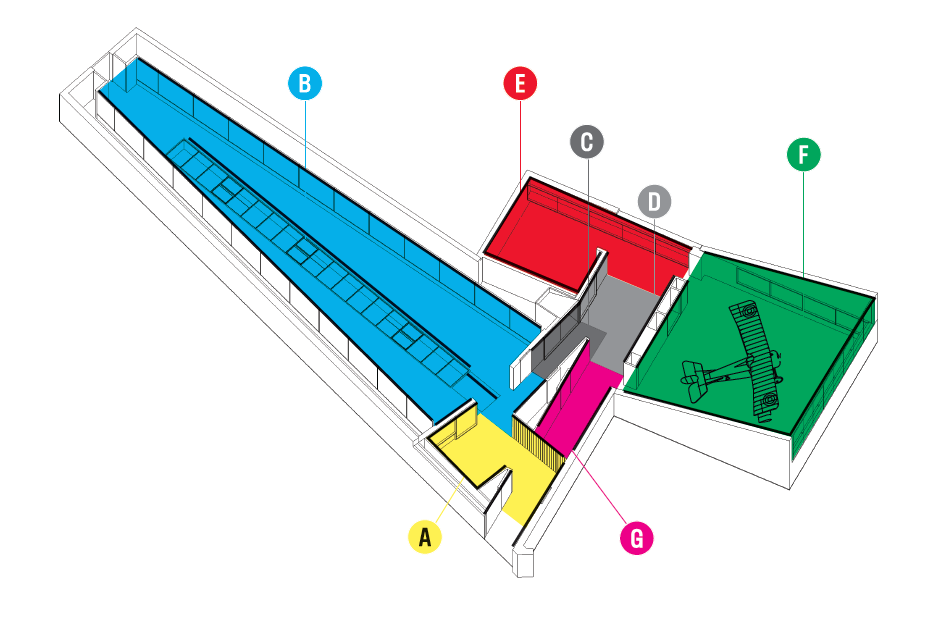Visits and tours
The Visitor
Center
Serving as an introduction to the battlefield museum, a series of short films and information panels in three languages (French, English and German) recount the history of the Great War, the Battle of the Somme and the creation of the Thiepval Memorial.
A database also allows visitors to explore the life stories of the 11,000 men missing in action, the soldiers whose mortal remains have never been found. Made possible by the hard work of volunteer researchers Mr. and Mrs. Linge, this database is often used by British visitors looking for traces of their ancestors.
The museum
The museum is dedicated to the history of the Battles of the Somme, offering a unique visitor experience which is both informative and emotionally-charged. The 400m² permanent exhibition space houses a combination of period items, archaeological finds, multimedia tools and a life-size replica of the aircraft flown by Georges Guynemer. The immense fresco (60 metres in length) created by Joe Sacco offers a unique visual representation of the battlefield as it stood on 1st July 1916.
The museum experience blends contemporary representations, archaeological artefacts, collections, life-size installations and a variety of educational multimedia materials. Together, they form a thoroughly immersive whole.
Joe Sacco’s fresco is an innovative combination of art and history, the only work of its kind in a museum of modern history: this thoroughly-researched panorama provides invaluable visual testimony of a highly symbolic day. Inspired by the Bayeux Tapestry, as well as the comic book tradition, it offers a historical and memorial narrative. Presented in an impressive 60m backlit frame, this vast panorama plunges visitors into the heart of the battlefield. Set into the floor in the centre of the room, a series of archaeological artefacts, period items and display screens tie in with the scenes depicted by Joe Sacco, including archive images and historical expertise.
This original museographic approach continues throughout the visit, with spaces cross-comparing the French and German perspectives, images of life behind the front line, tributes to the Missing, and a focus on the pioneering flying aces.
The visit is divided into several key sections, which are independent yet complementary. Similar to the approach adopted at the Péronne museum, the Thiepval visitor centre compares and contrasts the perspectives of the warring parties while maintaining a particular focus on the Battles of the Somme, and especially the great battle of 1916.
The museum is divided into 7 sections:

- A. Introductory space: the Battles of the Somme (1914-1918)
A massive animated map, incorporating contemporary photographs and film, illustrates the impact of the Great War on the Somme. This vast installation retraces the evolution of the front line between 1914 and 1918. It also offers some perspective on the sheer scale of the destruction and loss of life, still commemorated in the many cemeteries and memorials dotted throughout the region.
- B. The Battle of the Somme: the offensive of Summer 1916
The bloodiest battle of the entire First World War, for many British people the Battle of the Somme is synonymous with the Great War.
The room leads on to the panoramic fresco created by artist Joe Sacco, an hour-by-hour breakdown of the fateful day of 1st July 1916. Presented in an impressive 60m backlit frame, this vast panorama of the battlefield acts as an illustrated narrative of the military operations which took place on the bloodiest day in the history of the British Army: 20,000 soldiers lost their lives in the space of a few hours, mown down by German machine guns. Set into the floor in the centre of the room, a vast display case contains period objects and archaeological artefacts from the war. There are also a number of short films providing more background and detail, helping visitors to better understand the fresco. - C. The Germans and the Somme
An audiovisual installation explores the experiences of those on the other side of No Man’s Land, the Germany army which had dug in here in the Somme in the Autumn of 1914. The installations explores various themes: the Germans’ arrival, the day-to-day reality of occupation, defending the lines, preparing for battle, the retreat, remembering the war…
- D. French experiences of the Battles of the Somme
During much of the Great War, the east of the Somme was divided north to south by the front line, which was largely stable in 1915 and 1916. The civilian population endured a long and draining occupation. To the west of the front line was the zone known as the “rear.” Homes on both sides of the lines were devastated by artillery fire from all sides. The perspectives of France’s civilian population and soldiers are explored on a large map of the region, which also serves to illustrate the disastrous destruction and lasting impact of the conflict on the Somme region.
- E. The legions of “Disappeared”
Like a ‘Chapel of the Disappeared,’ an intimate space is dedicated to the memory of the thousands of men utterly destroyed by the war. An innovative multimedia installation provides an interactive insight into the individual life stories of the missing soldiers. The display cases feature objects of great symbolic value (items kept by families, letters, official documents, personal effects) which speak eloquently of these disappearances and the processes of familial and collective grieving.
- F. Hero figures: the flying aces
In contrast to the tragic masses of soldiers missing in action, the next section explores the myth-making which surrounded the first “flying aces.”
This large space includes a life-size replica of the aeroplane flown by Georges Guynemer, along with numerous portraits of aviators from the Great War. - G. Epilogue: the memorial landscape of the Somme
The epilogue evokes the Somme’s role as a focal point of European memory and international reconciliation. A film of the battlefields seen from the sky lays bare the scars which still define the landscape, along with the diversity and scale of the cemeteries, memorials and monuments erected on the sites of the major battles.
The centre also has a shop, lounge area, toilet facilities and picnic area for an all-round visitor experience.

